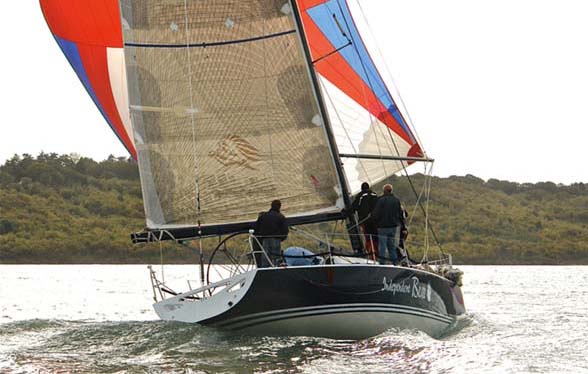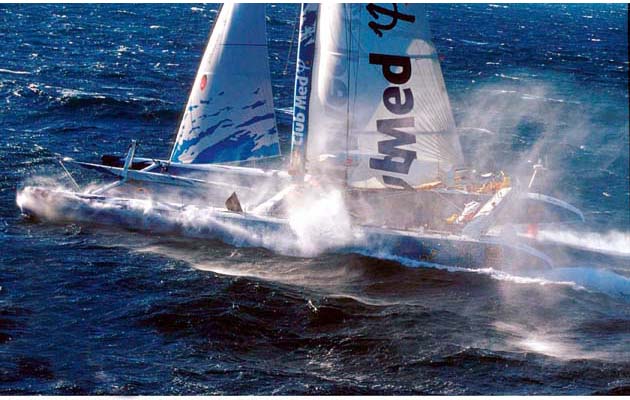31. Australia II
Built: 1983
Design: Ben Lexcen
Few yacht design innovations are both radical and immediate in their improvement. Australia II, the 12-metre that became the first yacht ever to wrest the America’s Cup from its American defender, was famously such an innovation.
Australia II defeated Dennis Conner’s Liberty in 1983 despite repeated efforts by the New York Yacht Club to prove its illegality (and attempts by the Australian team to keep it secret).
Lexcen had turned to aeronautical engineering techniques. When heeled over his innovative winged keel gave Australia II increased lift and a lowered centre of gravity for a significant upwind advantage.
The trade-off was an increase in wetted surface area, which had a detrimental effect on downwind performance, but Australia II was able to lead Liberty around the top mark to gain an early advantage.
Winged keels remained a feature of the America’s Cup – and were also prevalent in many more mainstream designs for a period – until the last IACC class races in 2007.

32. Independent Bear
Built: 1997
Design: Corby Yachts/Mark Downer
IRC is now a global rating, but in the 1990s it was known as CHS (Channel Handicap System) to reflect its Anglo-French focus.
Isle of Wight designer John Corby built a 41ft one-off, known as Independent Bear, which was so successful under the rule that she demolished all opposition in her first season.
Built of glassfibre and Kevlar with a lightweight foam core and carbon deck, she had a narrow beam but gained her stability with a very large keel bulb.
Independent Bear’s rating was raised a whopping 28 points the following year, but she still proved tough to beat. The CHS rule was adjusted, and saw a trend for wider IRC designs develop over subsequent years.
The ‘Bear’ programme also had a long-lasting effect on British racing, developing many young talented sailors aboard its successor Bear of Britain who have gone on to carve careers in professional yachting.

33. Club Med
Built: 2000
Design: Gilles Ollier/Multiplast
The first non-stop, no-limits round the world sailing competition, known as The Race, set off in December 2000 from Barcelona. The event, and the enormous catamarans that competed in it, certainly had detractors.
Team Philips, Pete Goss’s experimental wave-piercing design, was launched to great fanfare but broke up before the race had even started. Yachting World magazine was among those uncomfortable at the time with how high the stakes had been raised.
“Of all the round the world races that have ever started, this has the greatest potential for a body count,” then-editor Andrew Bray told The Sunday Times. In the end, there were no serious incidents, although the skipper of the Polish entry broke his leg on the final approach to the finish.
The boats built for the event, such as Club Med, proved that not only could giant multihulls get around the world, but they could also set previously unheard of ocean speed records: Club Med set a 24-hour record of 625.7 miles before The Race even started.
These designs then directly influenced a whole swathe of ‘G Class’ multihulls and Jules Verne trophy holders.
“The Race and the boat was the brainchild of Bruno Peyron,” recalls skipper Grant Dalton. “It had a semi wing mast, was 108ft long and in its day was fast, very fast. People said we couldn’t get it round, it was too big, too fast and the engineering wouldn’t stand up. They were almost right: after it tore itself apart on a transatlantic we had to totally re-engineer it.
“But not only was it the fastest boat ever round the world at that time, we were the first boat to break 600 miles in a day, which we did multiple times. It remains my best campaign as it was so ‘against the odds’.”
34. J/80
Built: 1992
Design: Rod Johnstone
The first asymmetric sportsboat, the J/80, was launched almost 28 years ago, one year after her larger stablemate, the J/105, pioneered the sprit concept for cruiser-racers.
Over 1,600 J/80s have been sold and dozens of sub-30ft asymmetric designs have been launched in her wake.
35. Farr 40
Built: 1996
Design: Farr Yacht Design
With its planing hull, high aspect foils and non-overlapping jib the Farr 40 was athletic, fast, and a whole lot of fun. The one-design attracted crew lists with names like Scheidt, Coutts and Cayard.
However, it was strictly owner-driven, so a category system was developed to establish who counted as an amateur, later adopted by ISAF.
36. Wild Oats XI
Built: 2005
Design: Reichel/Pugh
Nicknamed the ‘Swiss Army Knife’ for her many protruding foils, the 100ft eight-time Sydney-Hobart winner has carried various permutations of CBTF (canting ballast twin foil), twin daggerboards, a ‘caudal winglet’ on the trailing edge of the keel bulb, bow canard and DSS system.
37. Suhaili
Built: 1963
Design: William Atkin
Suhaili was the first yacht to achieve the impossible – solo, non-stop around the world – but she was not, herself, a radical design.
The double-ended style was pioneered by Colin Archer. Atkin scaled down lines from Archer’s safety-conscious pilot boats to produce a series of smaller, leisure yachts, one of which became Suhaili, winner of the 1969 Golden Globe.
38. Foiling Moth
Built: 2002
Design: Various
Ken Read comments: “In the grand prix world ‘flying’ is becoming more and more standard. The Moth evolved over the years as from a displacement style boat to a full-time flying rocketship.
“For sure the Moth was not the first boat to foil – far from it – but it became the poster child of a new foiling generation of boats. The Moth advertised to the mass market what is possible.”
39. l’Hydroptère
Built: 1994
Design: VPLP
Alain Thébault’s extraordinary 60ft l’Hydroptère was the first foiling ocean trimaran. It topped 50 knots in 2009, and once hit a peak speed of 61 knots before capsizing.
Vincent Lauriot Prévost says. “l’Hydroptère was a long development programme, maybe a 20-year project. It was a revolution. We expect to have flying ocean racing boats now.”
 40. Mini 6.50
40. Mini 6.50
Built: 1991 & 1993
Design: Fauroux
With just 21ft LOA to build a single-handed boat capable of crossing the Atlantic, designers are forced to find creative solutions in the Mini Proto class in the search for performance and stability. One development first tested in the Mini was the canting keel.
The first was Michel Desjoyeaux’s 1991 entry: “I made the first offshore racing boat with a canting keel, adjustable bowsprit folding along the sheer line, and a lot of details now common on those boats and bigger,” Desjoyeaux recalls.
“The adjustable bowsprit was for gybing the kite from the cockpit – in those days pilots were poor, and the kites were big.”
Ellen MacArthur then sailed another experimental Fauroux canting Mini, Le Poisson, in the 1995 Transat. Mark Turner recalls: “Minis are great for development as the loads are ‘hand-held’ level – so the original concept can be developed without the complications of power and hydraulics.
“Uniquely they didn’t get the hull fittings sorted in Ellen’s boat, so there was a totally blocked off area right up to the roof, which made living inside even smaller than a normal Mini. Of course that didn’t bother Ellen too much…
“Simpler to operate than water ballast, especially for the solo sailor (and much quicker to tack), the canting keel, which remains a mainstay system to this day, was an immediate performance leap. Of course it was the boat that started her solo racing career too.”




 40. Mini 6.50
40. Mini 6.50